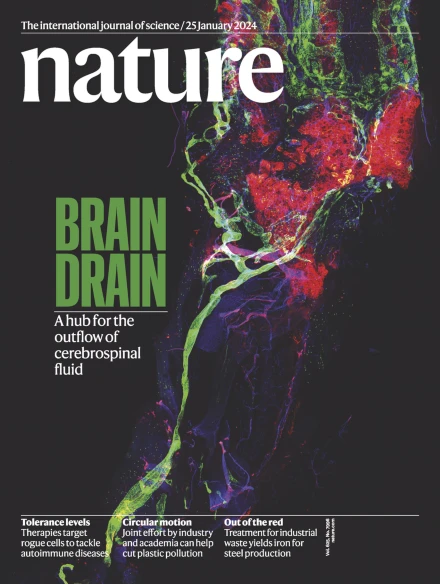Evidence of Coulomb liquid phase in few-electron droplets
IF 48.5
1区 综合性期刊
Q1 MULTIDISCIPLINARY SCIENCES
引用次数: 0
Abstract
Emergence of universal collective behaviour from interactions within a sufficiently large group of elementary constituents is a fundamental scientific concept1. In physics, correlations in fluctuating microscopic observables can provide key information about collective states of matter, such as deconfined quark–gluon plasma in heavy-ion collisions2 or expanding quantum degenerate gases3,4. Mesoscopic colliders, through shot-noise measurements, have provided smoking-gun evidence on the nature of exotic electronic excitations such as fractional charges5,6, levitons7 and anyon statistics8. Yet, bridging the gap between two-particle collisions and the emergence of collectivity9 as the number of interacting particles increases10 remains a challenging task at the microscopic level. Here we demonstrate all-body correlations in the partitioning of electron droplets containing up to N = 5 electrons, driven by a moving potential well through a Y-junction in a semiconductor device. Analysing the partitioning data using high-order multivariate cumulants and finite-size scaling towards the thermodynamic limit reveals distinctive fingerprints of a strongly correlated Coulomb liquid. These fingerprints agree well with a universal limit at which the partitioning of a droplet is predicted by a single collective variable. Our electron-droplet scattering experiments illustrate how coordinated behaviour emerges through interactions of only a few elementary constituents. Studying similar signatures in other physical platforms such as cold-atom simulators4,11 or collections of anyonic excitations8,12 may help identify emergence of exotic phases and, more broadly, advance understanding of matter engineering. The emergence of universal collective behaviour is demonstrated through collisions of electron droplets containing up to five particles, which exhibit strong all-body correlations characteristic of a Coulomb liquid.

少电子液滴中库仑液相的证据
在一个足够大的基本成分群体中,相互作用产生普遍的集体行为是一个基本的科学概念。在物理学中,波动微观观测的相关性可以提供有关物质集体状态的关键信息,例如重离子碰撞中的定义夸克-胶子等离子体2或膨胀的量子简并气体3,4。介观对撞机,通过射击噪声测量,已经为奇异电子激发的性质提供了确凿的证据,如分数电荷5,6,列维子和任何子统计。然而,在微观层面上,弥合两粒子碰撞和随着相互作用粒子数量的增加而出现的集体现象之间的差距仍然是一项具有挑战性的任务。在这里,我们展示了在半导体器件中,由移动势阱通过y结驱动的电子滴的分配中包含多达N = 5个电子的全体相关性。利用高阶多元累积量和向热力学极限的有限尺寸缩放分析划分数据,揭示了强相关库仑液体的独特指纹。这些指纹很好地符合一个普遍的极限,在这个极限下,液滴的分裂是由一个单一的集体变量来预测的。我们的电子-液滴散射实验说明了协调行为是如何通过几个基本成分的相互作用而出现的。在其他物理平台上研究类似的特征,如冷原子模拟器4,11或任意子激发集合8,12,可能有助于识别奇异相的出现,更广泛地说,有助于促进对物质工程的理解。普遍集体行为的出现是通过包含多达五个粒子的电子液滴的碰撞来证明的,这些电子液滴表现出库仑液体的强全体相关性特征。
本文章由计算机程序翻译,如有差异,请以英文原文为准。
求助全文
约1分钟内获得全文
求助全文
来源期刊

Nature
综合性期刊-综合性期刊
CiteScore
90.00
自引率
1.20%
发文量
3652
审稿时长
3 months
期刊介绍:
Nature is a prestigious international journal that publishes peer-reviewed research in various scientific and technological fields. The selection of articles is based on criteria such as originality, importance, interdisciplinary relevance, timeliness, accessibility, elegance, and surprising conclusions. In addition to showcasing significant scientific advances, Nature delivers rapid, authoritative, insightful news, and interpretation of current and upcoming trends impacting science, scientists, and the broader public. The journal serves a dual purpose: firstly, to promptly share noteworthy scientific advances and foster discussions among scientists, and secondly, to ensure the swift dissemination of scientific results globally, emphasizing their significance for knowledge, culture, and daily life.
 求助内容:
求助内容: 应助结果提醒方式:
应助结果提醒方式:


